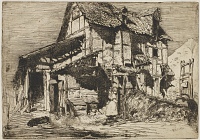Etchings Institutions search term: grolier club
The Unsafe Tenement | ||
| Number: | 18 | |
| Date: | 1858 | |
| Medium: | etching | |
| Size: | 158 x 226 mm | |
| Signed: | 'Whistler.' at lower right | |
| Inscribed: | 'Imp. Delatre. Rue St. Jacques. 171.' at lower left (2-3); erased (4) | |
| Set/Publication: | 'French Set', 1858 | |
| No. of States: | 4 | |
| Known impressions: | 76 | |
| Catalogues: | K.17; M.17; T.5; W.7 | |
| Impressions taken from this plate (76) | ||
KEYWORD
TITLE
'The Old Farm' (1858, Whistler). 1
'The Unsafe Tenement' (1858, Whistler). 2
'The Old Farm' (1861, V&A). 3
'L'habitation dangereuse' (1870s, Whistler). 4
'The Old Farm' (1874, Whistler). 5
'The Unsafe Tenement' (1874, Ralph Thomas, Jr (1840-1876)). 6
'The Dangerous Habitation' (1881, Union League Club). 7
'The Unsafe Tenement' (1886, Frederick Wedmore (1844-1921)). 8
The title was changed by Whistler between the publication of the 'French Set' in Paris and London in 1858. There is some doubt as to whether Whistler preferred the simple, original title, 'The Old Farm', to the more evocative title 'The Unsafe Tenement'. However, there is a problem with the word 'tenement', which had different meanings at different times and in different countries. A tenement was a building containing rented accomodation for several families, with common rights to the hall, stairs, yards and privies.
In the mid-1870s Whistler suggested another possible title, 'L'habitation dangereuse', which was translated by Samuel Putnam Avery (1822-1904) for the exhibition catalogue in 1881 as 'The Dangerous Habitation'. A more correct translation would be 'The dangerous house' or 'dangerous building' but this sounds rather awkward. 'Unsafe' does not carry quite as much emphasis as 'dangerous', but it is still not particularly appropriate.
1: Douze eaux-fortes d'après Nature.
2: Twelve Etchings from Nature.
3: 1 January 1861, V&A, Register for Prints, p. 33.
5: London Pall Mall 1874 (cat. no. 49).
6: Thomas 1874 (cat. no. 5).
7: New York 1881 (cat. no. 9).
8: Wedmore 1886 A (cat. no. 7).
DESCRIPTION
SITE
The territory of Alsace-Lorraine was created by the German Empire in 1871 after it annexed most of Alsace and the Moselle region of Lorraine following its victory in the Franco-Prussian War. The Alsatian part lay on the west bank of the Rhine and east of the Vosges Mountains, the Lorraine part in the Moselle valley to north of the Vosges Mountains. It reverted to France in 1919, to Germany in 1940, and to France by 1945.
9: Wedmore 1886 A (cat. no. 7).
DISCUSSION
'Whistler reveals a debt to Jacque and to the seventeenth-century Dutch etching tradition. The Unsafe Tenement may be compared to Jacque's plates Chaumière de paysans, G.78 and Maison du Paysan à Cricey, G.14, both of which take dilapidated half-timbered farmhouses for their subjects and employ peasant figures for staffage. Whistler used the same vocabulary of line and strong chiaroscuro found in Jacque to describe some areas of the wall in minute detail, while leaving others virtually unworked. He dramatized the composition by showing the building in raking light with a great web of black shadow. The carefully delineated contours and the short curved and vertical lines, sometimes crossed by horizontal lines to create a grid of shadow, once again recall the line of Charles Jacque.
10: Lochnan 1984 , pp. 36-38.
11: Isham Collection, New York Public Library, MEZAC 487470.

